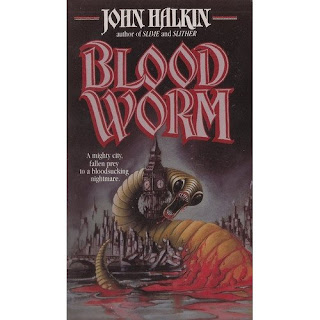Blood Worm
by John Halkin
p. 1988
After reading a lot of heavier fare lately, my mind cried
out for something mindless and entertaining, and directed my eyes to Blood Worm, because what screams ‘mindless
entertainment’ better than giant, bloodsucking worms terrorizing London? Penned
in the late eighties by John Halkin, author of such revolutionary literature as
Slither, Slime, and Squelch, and
with a hilariously over the top cover featuring a slathering serpent rising
from untold bloody depths to twine itself around a crumbling Big Ben, Blood Worm seemed like just the remedy I
needed, but sadly it fell prey to the old standard for horror books of its sort:
too ridiculous to be taken seriously, but not ridiculous enough to circle back
around to awesome.
There’s nothing wrong with the mechanics of Halkin’s prose.
If anything, it’s too ordinary.
Riddled with clichés—such as the hero championing his wild theories, whom no
one believes until it’s too late, the constantly-in-peril child, even a disorderly
death scene where a former soldier suffers from ‘Nam flashbacks while he is
devoured by beetles—Blood Worm just
tries a bit too hard to be something it has no chance of being. Bloodsucking
worms and beetles are swarming over small town England; nobody cares that the
hero’s wife was unfaithful to her marriage or that another character feels
shame at her cowardice. All of these tedious things detract from the
BLOODSUCKING WORMS.
And let’s talk about those worms for a minute here.
The cover of Blood
Worm, which undoubtedly drew me to the book in the first place (years ago,
before it sat on my shelf collecting dust), presents a gigantic, skyscraper-sized
beastly worm, but this is false advertising. The worms in the book never reach this size. At most they are
human-sized, and even at that size, they aren’t even the biggest threat in the
novel. That honor is bestowed upon the green and pink beetles from which the
worms emerge. Dazzling and deadly, it is the beetles we see first and the
beetles which are significantly harder to defeat, especially since they present
a double threat as they also eat away at the wooden infrastructure of the town’s
buildings, threatening collapse if not properly inspected. And here is exactly why
I suppose nonexistent Megaworm got to star on the book cover: it’s just not as thrilling to tell a story
about the dangers of compromised structural integrity.
But, like the reporter in the story who sensationalizes the
insect threat and coins the term ‘Blood Worm’ for the headlines, the
advertisers of Blood Worm know how to
get ya.
I know this stretches the bounds of believability that I
expected anything at all from a book called Blood
Worm, but I must admit it was a terrible letdown. I expected to read the
literary equivalent of a bad SyFy movie—you know, like Mansquito or
Arachnophobia or Dinocroc or any of the wretched tripe you catch on Saturday
morning television or at 3 a.m. when you can’t sleep. Blood
Worm started off promisingly but quickly failed to meet my expectations.
Perhaps this was just bad timing. Blood Worm seems like the type of book I would have loved to read
when I was younger, laying on the beach in the summertime, lazily soaking in
the cheesy action—the kind of book you can put down at any time to do something
better or from which you can still absorb most of the bullet points no matter what
sort of commotion is going on around you in the physical world. Perhaps this
relaxed setting would have been more conducive to my enjoyment of Blood Worm.
... Then again, delivering the super-sized bloodsucking
beasts the cover promised us certainly
couldn’t have hurt.

No comments:
Post a Comment